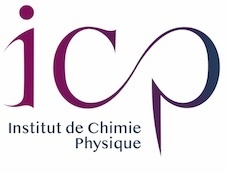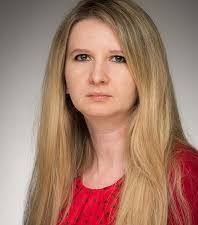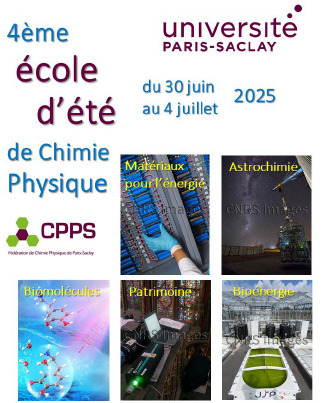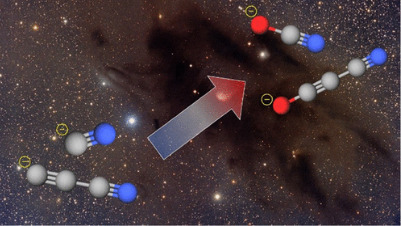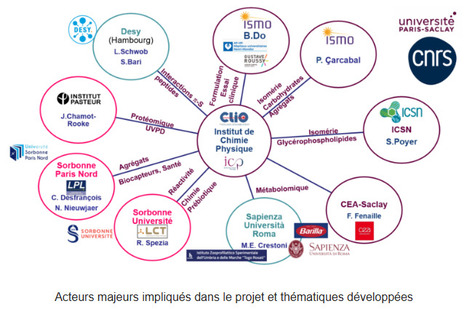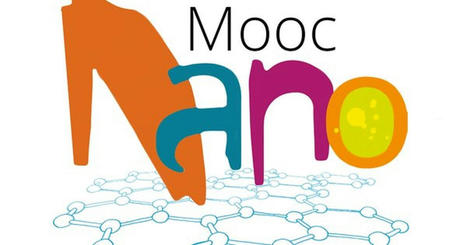 Your new post is loading...

|
Scooped by
Institut de Chimie Physique
May 25, 12:38 PM
|
Le journal du CNRS via le "Focus Sciences" met en lumière le projet "Réactivité Ultrarapide des Biomolécules sous Irradiation" - RUBI coordonné par Aurélien de la Lande et financé par l’Agence nationale de la recherche (ANR). Comprendre les effets de l’irradiation passe par l’exploration des phénomènes ultrarapides. En modélisant les mouvements atomiques et électroniques à des échelles de temps infimes, les scientifiques lèvent le voile sur la dynamique moléculaire qui se joue juste après l’impact d’un rayonnement intense sur des molécules biologiques (ADN, protéines…). Lien vers le communiqué

|
Scooped by
Institut de Chimie Physique
May 25, 1:10 PM
|
Cet évènement sur la thématique des réactions ion-molécule pour l'astrochimie s'est déroulé à l'Institut Pascal - Université Paris-Saclay du 7 au 18 avril 2025 et a remporté un franc succès. Organisé par Roland Thissen et ses collaborateurs, cet événement a reçu le support de l'Institut Pascal, de la GS Chimie, de la GS physique et de Soleil Synchrotron. Lien vers le programme A cette occasion, un séminaire grand public a aussi été proposé par Daniela Ascenzi (Department of Physics - University of Trento - Italy) « Gas phase astrochemistry: from lab to the interstellar space and planetary systems » le mercredi 9 avril 2025.

|
Scooped by
Institut de Chimie Physique
May 26, 3:46 PM
|
ICP Agenda - PhD Day ICP 2 juin !
La journée des doctorants "PhD Day" de l'ICP aura lieu le 2 juin en salle Magat. Communications orales, session poster et traditionnel barbecue, le programme arrive bientôt ! Programme

|
Scooped by
Institut de Chimie Physique
June 2, 2:26 PM
|
La subdivision de Chimie sous Rayonnement et de Radiochimie (CRRC) organise le 3 juin 2025 la 2nde journée "Nucléaire et Radiolyse" (JNR2025) à l'Université Paris-Saclay, bâtiment Henri Moissan (n°670), Amphithéâtre Hervé Daniel. Cette journée interdisciplinaire, vulgarisée et gratuite a pour but de faire découvrir les nombreuses disciplines liées à la radiochimie et la chimie sous rayonnement. Au programme, six conférences invitées sur des thèmes variés : Médecine, Patrimoine, Environnement, Histoire, Sûreté, Energie, suivies de temps d’échanges avec l’auditoire. Etudiant.e.s, Enseignant.e.s. Programme détaillé

|
Scooped by
Institut de Chimie Physique
May 26, 3:41 PM
|
ICP Agenda - Séminaire ICP Sylwia Ptasinska 4 juin 14h
Sylwia Ptasinska Professeur à l'Université de Notre Dame (Radiation Laboratory) sera présente à l'ICP en tant que professeur invitée du 3 au 16 juin. Elle donnera un séminaire intitulé: "Radiation-Induced Molecular Changes as a Probe for Low-Temperature Plasma Chemistry". Ce séminaire aura lieu mercredi 4 juin à 14h salle Magat.

|
Scooped by
Institut de Chimie Physique
May 26, 3:56 PM
|
FOCUS#4 se tiendra le jeudi 12 juin 2025 à l'Ecole Polytechnique L'objectif de FOCUS est de fédérer la communauté du plateau de Saclay (IP-Paris et Université Paris-Saclay) travaillant sur des thématiques scientifiques abordant les dynamiques ultrarapides (ou presque). Programme et inscription : https://focus.sciencesconf.org/resource/page/id/5

|
Scooped by
Institut de Chimie Physique
May 15, 10:58 AM
|
La Fédération de Chimie-Physique de Paris Saclay (CPPS) organise sa 4ème école d’été « Physico-chimie et problématiques sociétales contemporaines" Le but de l’école est de sensibiliser les étudiant(e)s à l’importance de la chimie physique et aux possibilités considérables de formation offertes par l’université dans ce domaine. Informations et inscription Contact : Hélène Pasquier

|
Scooped by
Institut de Chimie Physique
May 25, 1:44 PM
|
The second edition of "Theory around XFEL" will be organized in Paris on September 24th-26th. The workshop will gather theoreticians (experimentalists are also welcome) working in the field of X-ray spectroscopies with keynote speakers expert in these spectroscopies, from chemistry, biology and physics. The participation to the workshop is free of charge. Registration is open. Registration link

|
Scooped by
Institut de Chimie Physique
May 25, 2:14 PM
|
Le Workshop Photo-Emission en milieu dilué vise à rassembler les expérimentatrices/experimentateurs et théoriciens/théoriciennes intéressé(e)s par le processus de photoémission sur des systèmes isolés en phase gazeuse (atomes, molécules, agrégats jusqu’aux nanoparticules) ou jet liquide sous vide, que ce soit comme un outil de caractérisation de la matière, états électroniques et structures moléculaires, ou d’étude de l’interaction matière-rayonnement comme la dynamique d’ionisation aux temps ultra-courts. Les inscriptions et soumissions sont ouvertes depuis le 22 mai 2025. Date limite des soumissions le 30 juin 2025 Informations et inscription/soumission

|
Scooped by
Institut de Chimie Physique
May 25, 2:00 PM
|
The 33rd Miller Conference on Radiation Chemistry will be held in Dubrovnik, Croatia, from October 5 to 10, 2025. A Workshop for Early Career Scientists will precede the conference on October 5, running from morning to evening. Information and registration

|
Scooped by
Institut de Chimie Physique
May 25, 2:21 PM
|
Click & Read, l’extension indispensable pour accéder aux publications scientifiques en un clic ! L’extension web Click & Read permet d’accéder à un grand nombre de productions scientifiques pour tous les agents du CNRS et de l'enseignement supérieur et de la recherche (ESR). Lien vers les informations

|
Scooped by
Institut de Chimie Physique
May 15, 10:14 AM
|

|
Scooped by
Institut de Chimie Physique
March 26, 10:45 AM
|
CNRS Chimie met en lumière les travaux récents de Xiaojiao Yuan, Girlie Eunice Lopez, Viet-Dung Duong, Samy Remita, Hynd Remita et leurs collaborateurs. "La lumière pour scinder l’eau grâce à des nanoparticules de polymère" Des chercheurs ont découvert que de minuscules particules de polypyrrole, un polymère organique, peuvent capter la lumière visible pour oxyder l’eau et produire de l’oxygène. Cette avancée, publiée dans la revue Small, ouvre des perspectives pour développer des matériaux durables dans la quête d’énergie propre et renouvelable. Lien vers le communiqué de presse Lien vers la publication dans Small "Semiconducting Overoxidized Polypyrrole Nano-Particles for Photocatalytic Water Splitting"

|
Scooped by
Institut de Chimie Physique
April 10, 6:43 AM
|
CNRS Chimie met en lumière les travaux récents de Zhiwen Jiang, Carine Clavaguéra, Sergey A. Denisov, Jun Ma & Mehran Mostafavi Des chercheurs révèlent le rôle crucial du cuivre et ses mécanismes d’action dans les premières étapes de réduction du CO₂ en produits à haute valeur ajoutée. L’étude, qui combine radiolyse pulsée et simulations moléculaires, montre quelles espèces de catalyseur de cuivre sont les plus efficaces et pourquoi. Une étape clé vers la valorisation durable du CO2 et une économie circulaire du carbone. Lien vers le communiqué de presse Lien vers la publication dans Journal of the American Chemical Society "Role of Oxide-Derived Cu on the Initial Elementary Reaction Intermediate During Catalytic CO2 Reduction"

|
Scooped by
Institut de Chimie Physique
April 10, 9:19 AM
|
Nicolas Solem, Claire Romanzin et Roland Thissen ont publié récemment un article dans ACS Earth and Space Chemistry: "CN– and C3N– Reactivity with Formic and Acetic Acid, Acetaldehyde, and Methanol" Lien vers la publication The anion-molecule reactivity of CN– and C3N–, produced by dissociative electron attachment of the respective bromide precursors, with four oxygenated molecules has been investigated in a guided ion beam mass spectrometer, and absolute reaction cross-sections are derived as a function of collision energy. The four targets are formic acid, acetic acid, acetaldehyde, and methanol. Exothermic and endothermic proton transfer has been observed as the main reaction channel, with differences in cross-section between the two anions. Oxidation of the anions is also observed, forming OCN– and OC3N–, for both anions and limited to the targets with endothermic proton transfer for CN–. This reaction requires several rearrangements and, therefore, a long-lived complex to proceed. Other complex-mediated products are observed for C3N– but not for CN–, interpreted as the ability to proceed through a long-lived complex because of less easy proton transfer for C3N–. Comparison between the present results at low-collision energy, models, and previous studies are producing a coherent picture. Several products observed with C3N– were missing formation enthalpies. Using the experimental exothermic behavior, it was possible to determine the upper limit values for enthalpies for the formation of OC3N– (0.39 ± 0.25 eV), [H2OC3N]− (0.39 ± 0.25 eV), C4N– (0.65 ± 0.25 eV), and CH3C3N– (3.52 ± 0.25 eV).

|
Scooped by
Institut de Chimie Physique
April 10, 8:46 AM
|
Lea Maria Ibele, Eduarda Sangiogo Gil, Evaristo Villaseco Arribas et Federica Agostini ont publié récemment un article dans Physical Chemistry Chemical Physics: "Simulations of photoinduced processes with the exact factorization: state of the art and perspectives Physical Chemistry Chemical Physics" Lien vers la publication This perspective offers an overview of the applications of the exact factorization of the electron–nuclear wavefunction to the domain of theoretical photochemistry, where the aim is to gain insights into the ultrafast dynamics of molecular systems via simulations of their excited-state dynamics beyond the Born–Oppenheimer approximation. The exact factorization offers an alternative viewpoint to the Born–Huang representation for the interpretation of dynamical processes involving the electronic ground and excited states as well as their coupling through the nuclear motion. Therefore, the formalism has been used to derive algorithms for quantum molecular-dynamics simulations where the nuclear motion is treated using trajectories and the electrons are treated quantum mechanically. These algorithms have the characteristic features of being based on coupled and on auxiliary trajectories, and have shown excellent performance in describing a variety of excited-state processes, as this perspective illustrates. We conclude with a discussion on the authors' point of view on the future of the exact factorization.

|
Scooped by
Institut de Chimie Physique
March 26, 10:55 AM
|
Dimitra Markovitsi et ses collaborateurs ont publié récemment un article dans Biomolecules: "Factors Affecting the Population of Excited Charge Transfer States in Adenine/Guanine Dinucleotides: A Joint Computational and Transient Absorption Study"
Lien vers la publication There is compelling evidence that the absorption of low-energy UV radiation directly by DNA in solution generates guanine radicals with quantum yields that are strongly dependent on the secondary structure. Key players in this unexpected phenomenon are the photo-induced charge transfer (CT) states, in which an electric charge has been transferred from one nucleobase to another. The present work examines the factors affecting the population of these states during electronic relaxation. It focuses on two dinucleotides with opposite orientation: 5′-dApdG-3′ (AG) and 5′-dGpdA-3′ (GA). Quantum chemistry calculations determine their ground state geometry and the associated Franck–Condon states, map their relaxation pathways leading to excited state minima, and compute their absorption spectra. It has been shown that the most stable conformer is anti-syn for AG and anti-anti for GA. The ground state geometry governs both the excited states populated upon UV photon absorption and the type of excited state minima reached during their relaxation. Their fingerprints are detected in the transient absorption spectra recorded with excitation at 266 nm and a time resolution of 30 fs. Our measurements reveal that in the large majority of dinucleotides, chromophore coupling is already operative in the ground state and that the charge transfer process occurs within ~120 fs. The competition among various relaxation pathways affects the quantum yields of the CT state formation in each dinucleotide, which are estimated to be 0.18 and 0.32 for AG and GA, respectively.

|
Scooped by
Institut de Chimie Physique
April 10, 9:05 AM
|
Ba Lich Pham, Alireza Ranjbari, Abderrahmane Tadjeddine, Christophe Humbert et leurs collaborateurs ont publié un article dans Symmetry: "Sum-Frequency Generation Spectroscopy at Aqueous Electrochemical Interfaces" Lien vers la publication The electrochemical interface (EI) is the determining factor in the yield and mechanism of sustainable energy storage and conversion systems due to its intrinsic functionality as a dynamic junction with the symmetry breaking of the molecular arrangement for complex reaction fields of mass transport and heterogeneous electron transfer. At the EI, the externally applied potential stimulus drives the formation of the electrical double layer (EDL) and governs the adsorption of interfacial adsorbate species in aqueous electrolyte solutions. Water and its aqueous electrolyte systems are integral and quintessential elements in the technological innovation of various fields such as environmental sciences, electrocatalysis, photocatalysis, and biochemistry. Although deciphering the structure and orientation of water molecules at the electrode–electrolyte interface in a quantitative analysis is of utmost importance, assessing chemical phenomena at the buried EI was rather challenging due to the intricacy of selecting interface-specific methodologies. Based on the non-centrosymmetry of the interfaces’ electronic properties, sum-frequency generation (SFG) spectroscopy has been manifested to be specifically well suited for probing the EI with detailed and comprehensive characteristics of adsorbates’ chemical structures and electrochemical events. In this review, we holistically engage in a methodical and scrupulous assessment of the fundamental EDL models and navigate towards the connection of the renowned Stark effect and potential dependence of SFG spectra at heterogeneous electrode–electrolyte interfaces. We dissect the development, advantages, and available geometrical configurations of in situ SFG spectroscopy in harnessing the EI. A broad spectrum of applications in unraveling the water orientations and rationalizing the convoluted mechanism of fuel-generated electrocatalytic reactions with particular encumbrances and potential resolutions is underscored by leveraging SFG spectroscopy.

|
Scooped by
Institut de Chimie Physique
April 10, 9:40 AM
|
La région Ile de France a attribué une subvention de 895 000 € dans le cadre de l’appel à projet SESAME2024 au projet porté par l’Institut de Chimie Physique en partenariat avec de laboratoires de l’Université Paris-Saclay, de la région Ile de France et européens pour la mise à niveau de la plateforme de spectroscopie IRMPD CLIO/SMAS. Cette subvention permettra l’achat de lasers IR pour la plateforme et l’installation de deux nouveaux spectromètres de masse de type piège à ions dont un à très haute résolution et à très haut champ magnétique. La plateforme CLIO/SMAS de l’ICP est fortement impliquée dans de réseaux nationaux tels que l’Infrastructure de recherche Infranalytics et le PEPR LUMA qui soutiennent également ce projet. Contact: Debora Scuderi

|
Scooped by
Institut de Chimie Physique
April 10, 9:31 AM
|
Bravo à Raphaël Vangheluwe qui effectue sa thèse dans le groupe ThéoSim pour avoir gagné le prix du meilleur poster dans le cadre du Colloque Alain Bouyssy. "Accelerating the exploration of nanoclusters structures with machine learning inerfaced with particle swarm optimisation" Ce colloque s'est tenu le 12 décembre 2024 et a été organisé par la Graduate School de Physique de l'Université Paris-Saclay.

|
Scooped by
Institut de Chimie Physique
April 11, 2:38 AM
|
ICP actualité - Réseaux sociaux de l'ICP
L'ICP vous annonce la création de sa page LinkedIn et de son compte Bluesky ! N'hésitez à vous abonner, à relayer les posts et aussi à nous envoyer de l'information à diffuser.

|
Scooped by
Institut de Chimie Physique
April 11, 2:06 AM
|
ICP agenda - PhD Days de l'ICP
Les PhD Days de l'ICP auront lieu le lundi 2 juin et le mardi 3 juin matin en salle Magat (bâtiment 349). Participez nombreux ! Au programme: communications orales et session poster.

|
Scooped by
Institut de Chimie Physique
April 10, 10:21 AM
|
The Institute for the Sciences of Light and the BioProbe interdisciplinary program at Université Paris-Saclay are pleased to invite you to the second edition of ChemPhysBio, an interdisciplinary summer school designed to bridge the fields of chemistry, physics, and biology. 16-20 June 2025
Program and details: https://chemphysbio2025.sciencesconf.org/

|
Scooped by
Institut de Chimie Physique
April 10, 9:55 AM
|
Opportunités de financement pour des projets novateurs alignés sur les axes de recherche de l'OI BioProbe. Découvrez les différents programmes disponibles et les modalités pour soumettre vos candidatures. Certains appels à projets sont ouverts toute l'année, offrant ainsi une flexibilité qui permet de s’adapter à vos besoins. D'autres fonctionnent par campagnes annuelles, avec des périodes d'ouverture spécifiques.

|
Scooped by
Institut de Chimie Physique
April 11, 2:16 AM
|
|



 Your new post is loading...
Your new post is loading...




